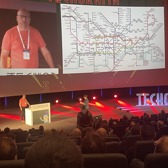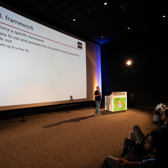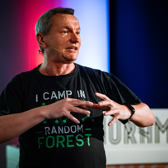Data Engineering with Microsoft Fabric
UFAB
5 days
Interested in a private company training? Request it here.
Not ready to book yet? Request an offer here.
Introduction into Microsoft Fabric
The chapter introduces the data lake approach. It also provides a high-level overview of the building blocks of Microsoft Fabric and how to get started. The Data Mesh architecture is discussed and compared with Microsoft Fabric.
- What is Microsoft Fabric?
- From traditional data warehousing to data lakes
- Data Mesh Architecture
- Working with Task Flow
- Microsoft Fabric Licensing
- Monitor Microsoft Fabric
- Domains and Workspaces in Microsoft Fabric
- LAB: Getting started with Microsoft Fabric
Introduction to Data Lakes
Microsoft Fabric is built on the idea of replacing a traditional data warehouse with a data lake. This module explains why and how the relational data warehouse could be replaced by a file-based data lake.
- From Data Warehouse to Data Lake
- Volume, velocity and variety problems
- From Data Lake to Lakehouse
Microsoft OneLake
Microsoft OneLake is the OneDrive equivalent for business data: A place to host files (data lake or delta lake) and tables.
- What is OneLake?
- Creating Workspaces
- Working with Domains
- Workspaces and Source Control: Azure DevOps and Github integration
Storing Data in OneLake
OneLake provides a single, unified, logical data lake for your whole organization. Like OneDrive, OneLake comes automatically with every Microsoft Fabric tenant and is designed to be the single place for all your analytics data.
- Creating a LakeHouse
- Manually loading data in Lakehouse
- The Lakehouse SQL Analytics Endpoint
- Create a semantic model
- Working with Shortcuts
- Connecting External Applications with Microsoft OneLake
- LAB: Setting up Lakehouses in OneLake
Getting started with Data Factory
Data Factory allows you to ingest, prepare and transform data from a rich set of data sources like databases, files, cloud data sources,... This chapter illustrates how to use Activities to build pipelines that ingest data in a Lakehouse.
- What is Data Factory?
- Creating Data Pipelines
- The Copy Data Activity
- Executing and Monitoring Data Pipelines
- LAB: Ingesting data using Pipelines
Authoring advanced Pipelines
This module dives deeper into the process of building a Fabric pipeline. The module mainly focusses on how to work with expressions, variables and parameters to make dynamic pipelines.
- Working with Expressions
- Variables and Parameters
- Using Looping and Conditional Logic in pipelines
- Debugging a pipeline
- LAB: Authoring and debugging advanced Pipeline
Ingest and Transform data using Dataflow Gen2
With Dataflows you can visually design data transformations without the need to learn yet another tool or language. Dataflows in Microsoft Fabric are based on Power Query Online.
- Creating Queries to load data
- Applying Transformations
- Appending and Merging Queries
- Query Folding
- Using Dataflows inside a Pipeline
- Managing connections
- LAB: Ingesting and Transforming Data using Dataflows
Data Engineering with Spark
Data engineering is the process of designing and building systems that let people collect and analyze raw data from multiple sources and formats. Using popular languages such as Python, SQL and R data can be loaded, transformed and analyzed via interactive notebooks.
- Introducing Apache Spark
- Creating Environments or Apache Spark clusters
- Working with Notebooks in Fabric
- Magic commands
- Visual Studio Code integration
- Scheduling Notebooks
- Microsoft Fabric decision guide: Copy activity, Dataflow or Spark
- Using Python Notebooks
- LAB: Getting started with Notebooks in Microsoft Fabric
Data wrangling using PySpark and Spark SQL
PySpark and Spark SQL allow users to perform complex data processing tasks with few lines of code using Notebooks.
- The SparkSession, SparkContext and SQLContext objects
- Reading and writing data using DataFrames
- Data Cleansing using PySpark
- Grouping and aggregating data in PySpark
- Joining DataFrames
- Using Spark SQL to select and manipulate data
- Visualizing data using Notebooks and DataFrames
- LAB: Data wrangling using PySpark and Spark SQL
Working with Delta Tables
Delta Lake is an optimized storage layer that provides the foundation for storing data and tables in a Fabric lakehouse. Learn how to create, query and optimize Delta Tables in a Microsoft Fabric.
- What is a Delta Lake?
- Working with Delta Tables
- Managing Schema change
- Version and Optimize Delta Tables
- LAB: Working with Delta Tables
Building a Fabric Data Warehouse
A Synapse Data Warehouse is a database that stores data in OneLake and provides a medium to interact with the database using SQL commands.
- The SQL analytics endpoint of the Lakehouse
- Creating tables in a Synapse Data Warehouse
- Ingesting data using pipelines
- Ingesting data using T-SQL
- Querying the Warehouse
- The Default Power BI semantic model
- LAB: Creating and using a Warehouse
Fabric SQL Databases
Sometimes the restrictions on a Fabric Data Warehouse make it difficult to use for applications that are closer to the operational side. With Fabric SQL Databases, an operational database becomes available, with constraints, indexes, and many more features that SQL Server users might be used to.
- What is Fabric SQL Database
- Connecting clients to the database
- Controlling security
- Disaster recovery
- Fabric SQL Database versus Fabric Warehouse
Real-Time Analytics in Fabric
Real-Time Analytics is a fully managed big data analytics platform optimized for streaming, time-series data. It contains a dedicated query language and engine with for searching structured, semi-structured, and unstructured data in close to real-time.
- Creating a KQL database
- Ingesting data into tables
- Query data using KQL
- Create and manage Eventstreams
- LAB: Working with Real-Time Analytics
Reporting in Fabric
Power BI transforms your company's data into rich visuals for you to monitor your business and get answers quickly. Learn how to connect to your data stored in Microsoft Fabric using Power BI.
- Creating Power BI Reports
- DirectQuery vs Import with Microsoft OneLake
- Using and configuring Direct Lake Mode
- LAB: Creating Power BI Reports
Data Activator
Data Activator in Microsoft Fabric takes action based on what's happening in your data. Learn how to setup conditions against your data and trigger actions like run a Power Automate Flow when the conditions are met.
- Creating and using Reflexes
- Defining Triggers, Conditions and Actions
- Getting data from Reports or Eventstreams
- LAB: Use Data Activator in Fabric
Microsoft Fabric is an all-in-one analytics solution for enterprises that covers everything from data movement to data science, real-time analytics, and business intelligence. It offers a comprehensive suite of services, including data lake, data engineering, and data integration, all in one place. In this 5-day course, you will learn about and experience the major parts of Microsoft Fabric.
This course is targeted at data engineers and BI professionals who want to build and use lakehouses and data warehouses using Microsoft Fabric.









